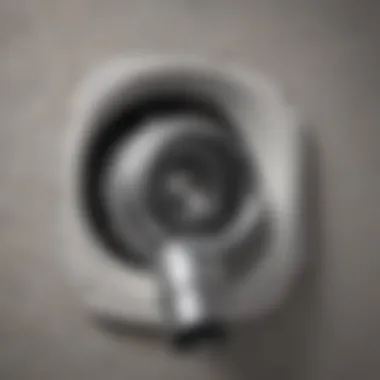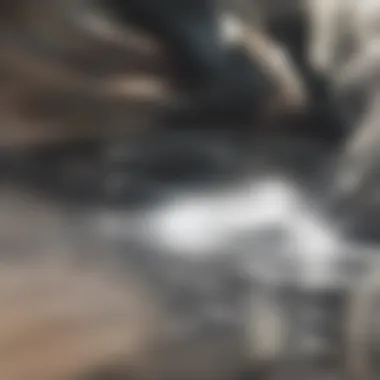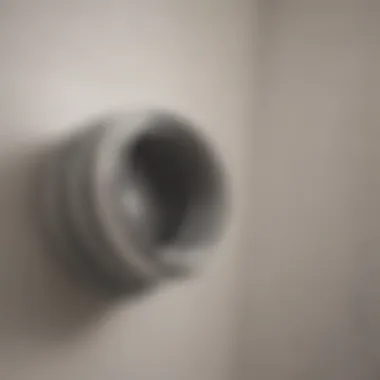Essential Steps to Check Your Dryer Vent Effectively


Intro
Checking the vent on your dryer is a critical aspect of maintaining its performance and ensuring safety in your home. Over time, lint and debris can accumulate in the vent, leading to reduced efficiency and increased risk of fire hazards. Understanding how to inspect the vent properly can enhance your dryer's functionality and prolong its lifespan.
Regular maintenance of your dryer vent goes beyond just ensuring clean dry clothes. It influences energy consumption, affects drying times, and impacts the overall safety of your home environment. In this guide, we will cover essential steps to check your dryer vent, identify common issues, and provide valuable insights into best practices for both electric and gas dryers. By adhering to these guidelines, you can keep your appliance running efficiently and securely.
Regularly checking your dryer's vent can prevent potential hazards and save you money on energy bills.
As we move forward, we will delve into key components of dryer vents, procedures for assessment, and the implications of neglecting timely maintenance. This information is designed to equip you with the knowledge needed to maintain an efficient drying system.
Understanding the Importance of Dryer Vent Maintenance
Regular maintenance of dryer vents is often overlooked in many households. This oversight can lead to significant drawbacks that not only affect the dryer’s performance but also contribute to safety hazards. In this article, we will explore the essentials of dryer vent maintenance, emphasizing both its practical benefits and critical risks associated with neglect.
Why Dryer Vent Maintenance Matters
Maintaining dryer vents should be a priority for homeowners. The primary reason is that it helps to ensure the dryer operates efficiently. When the vents are clean and free from obstructions, the dryer can perform its function optimally. This means less energy is used, leading to lower utility bills. Moreover, regular maintenance also extends the lifespan of the dryer itself. A well-maintained appliance does not have to work as hard, resulting in less wear and tear.
This is not just about appliance efficiency. Proper vent maintenance significantly affects the quality of the air within the home. Blocked vents can cause hot air and moisture to leak into the living area, leading to dampness and fostering mold growth. The subsequent damage can affect the walls and furnishings, leading to more extensive repair costs.
Impact on Dryer Efficiency
The efficiency of dryers can diminish over time due to lint and debris accumulation in the vents. This obstruction forces dryers to work harder to expel hot air, which leads to longer drying times.
Some key impacts on efficiency include:
- Increased Energy Consumption: When dryers function at less than optimal efficiency, they utilize more energy, which can cause spikes in electricity bills.
- Prolonged Drying Cycles: When a vent is blocked, it takes longer for clothes to dry, which can be frustrating for users. A typical cycle might extend from 30 to 90 minutes or more, wasting time and energy.
Fire Hazards Related to Blocked Vents
One of the most serious implications of poor dryer vent maintenance is the risk of fire. Lint is highly flammable and, when accumulated in the vent, poses a significant fire hazard. Statistics show that failure to clean dryer vents is a leading cause of home dryer fires.
Here are some critical points regarding fire hazards:
- Lint Buildup: As lint accumulates, it increases the chance of igniting due to high temperatures generated during drying.
- Choking the Airflow: A blocked vent can lead to overheating, creating a potentially explosive situation.
Important: Dryers should be checked and maintained regularly to minimize the risk of fire. Simple preventative measures, such as cleaning the lint trap after every use and scheduling professional inspections, can greatly enhance safety.
Components of a Dryer Vent System
The components of a dryer vent system are critical to the overall performance and safety of your appliance. Understanding how these parts work together can help you ensure efficient operation and prevent common problems. A well-functioning dryer vent system is essential for proper air flow, minimizing lint build-up, and reducing the risk of fire hazards. Each component plays a specific role, and neglecting any part can lead to inefficiencies and safety incidents. This section explores these components in depth, allowing readers to recognize the importance of regular inspection and maintenance.
Overview of Dryer Vent Parts
The dryer vent system consists of several key parts that work together to facilitate the drying process. These include the vent hood, the ductwork, and the connection to the dryer itself.
- Vent Hood: This is located on the exterior of your home and allows hot, moist air to escape from the dryer to the outside. It should have a flapper that opens when the dryer is in use and closes when it is not.
- Ductwork: This is the pathway that connects the dryer to the vent hood. Ducts can be made from various materials and have different shapes, which affects efficiency. It is important to use appropriate duct materials to minimize build-up and ensure good airflow.
- Connection to the Dryer: This involves the area where the duct connects to the dryer. A tight seal at this junction is critical to prevent lint escape and ensure maximum air flow. Any gaps can lead to serious efficiency issues.
Types of Dryer Vents
Choosing the right type of dryer vent is crucial for maintaining the system's efficiency and safety. Below are the different types of dryer vents commonly used:
Rigid Vents
Rigid vents are made from metal and feature a straight design that promotes unobstructed air flow.


- Key Characteristic: The rigidity prevents any bending or kinking, allowing air to move freely.
- Benefits for This Article: Because they are less likely to accumulate lint compared to flexible alternatives, they are favored for long-term use.
- Advantages/Disadvantages: The primary advantage is effectiveness in maintaining airflow. However, installation may require more effort due to their rigidity.
Flexible Vents
Flexible vents are made from a thinner material that allows them to be bent and shaped easily.
- Key Characteristic: Their flexibility makes for easier installation in tight spaces.
- Benefits for This Article: They can be quickly routed around obstacles, making the setup process simpler for some homeowners.
- Advantages/Disadvantages: However, flexible vents can be prone to kinking, which may restrict airflow and lead to lint accumulation.
Plastic Vents
Plastic vents are less common and mostly used in certain applications.
- Key Characteristic: They are lightweight and easy to install due to their flexible nature.
- Benefits for This Article: While their lower cost is attractive, they do not always handle the heat as well as metal alternatives.
- Advantages/Disadvantages: The major disadvantage is that they can warp or melt under high temperatures, presenting a potential fire hazard.
Function of Each Component
Every part of a dryer vent system has a distinct function that contributes to overall performance:
- The vent hood allows the dangerous gases from dryers to escape the home, easy and swiftly.
- The ductwork must remain clean and clear of lint to keep air flowing freely.
- Lastly, the connection to the dryer must be secure to avoid any potential leaks or blockages.
Understanding the components of a dryer vent system is key to ensuring its proper function and avoiding serious issues.
Step-by-Step Guide to Checking the Dryer Vent
Properly checking the dryer vent is essential to ensure safety and efficiency in your laundry setup. This guide offers a systematic approach to evaluate your vent system, identifying potential issues and ensuring necessary maintenance. By following these steps, you can mitigate fire risks and optimize your dryer’s performance.
Preparation for Assessment
Before beginning the inspection, it is important to prepare effectively. This involves gathering the necessary tools and reinforcing safety measures.
Gather Necessary Tools
Collecting the right tools streamlines the process of checking the dryer vent. Tools you will need include a flathead screwdriver, a drill, and a flexible vent cleaning brush. These items are crucial for accessing various areas of the vent and addressing any clean-up tasks.
The unique feature of the flexible vent cleaning brush is its ability to reach areas that might be difficult to access otherwise. This efficiency makes it a popular choice because it aids in clearing lint and debris from the dryer vent, enhancing airflow and reducing risks of fire hazards. The convenience of having these tools at your disposal makes the task less daunting and more approachable.
Ensure Safety Precautions
Safety is paramount when dealing with appliance maintenance. Disconnect the dryer from its power source before starting any inspections. This measure prevents accidents or electric shock during the process.
The key characteristic of ensuring safety precautions is it significantly reduces the risk of injury while inspecting the vent. Additionally, it prevents damage to the dryer or vent system. Although these precautions may seem obvious, they are essential.
By practicing these safety measures, you establish a secure environment that allows for a thorough inspection of the dryer vent.
Inspecting the Exterior Vent
The first area to check is the exterior vent, which plays a crucial role in regulating airflow from the dryer to the outside. Begin by removing any visible debris or obstructions around the vent opening. Ensure the vent flap opens properly. If it does not, it may indicate a blockage or malfunction that needs further investigation.
A well-functioning exterior vent allows moist air to escape efficiently, preventing back draft problems. Regular checks can enhance dryer performance and extend the lifespan of both the vent and the dryer itself.
Checking the Interior Vent Duct
Next, focus on the interior vent duct leading from the dryer to the exterior vent. Detach the duct from the dryer to inspect for any accumulated lint or signs of damage. A significant build-up of lint can severely restrict airflow, forcing the dryer to work harder, which is inefficient.
Assess the duct condition for kinks or bends. These can disrupt airflow and trap lint, leading to a fire hazard over time. Ensure the duct is securely attached to both the dryer and the exterior vent to maintain optimal airflow.
Identifying Blockages and Damage


A critical part of the inspection is identifying any blockages or damage that may impair the dryer vent’s functionality.
Signs of Lint Build-Up
Look for signs of lint build-up within the duct and surrounding areas. Common indicators include longer than usual drying times or a burning smell when the dryer is operating. These are serious warnings that should not be ignored.
The distinctive feature of lint build-up is its ability to restrict airflow, increasing the risk of overheating and fire. Building awareness of these signs can greatly contribute to maintaining a safe and functional dryer.
Assessing Duct Condition
Finally, assess the overall condition of the duct. Inspect for any wear, cracking, or loose connections that may compromise its integrity. Any weaknesses must be addressed promptly, either through repairing or replacing the affected sections.
The necessity of assessing the duct condition is to ensure that air flows freely and efficiently through the vent system. Unattended, damaged ducts can lead to larger issues that further complicate dryer maintenance. Regular assessments can help catch these potential problems before they evolve into significant hazards.
By thoroughly inspecting both the exterior and interior components of your dryer vent, you not only enhance the performance of your dryer but also ensure safety for your home.
Common Problems Detected During Vent Check
Understanding common issues detected during a dryer vent check is crucial for maintaining safe and efficient operation. These problems can lead to reduced dryer performance, higher energy costs, and even serious fire hazards. Recognizing these issues early helps prevent emergencies and promotes a better drying experience.
Lint Accumulation
Lint accumulation is a major concern when checking the dryer vent. Over time, lint can build up in various parts of the vent system. This buildup not only restricts airflow but also increases the risk of fire. Regularly removing lint is essential for safety and efficiency.
To identify lint accumulation, inspect both the exterior and interior ducts. Look for visible lint inside the vent or on the exhaust hood. Additionally, if your clothes are taking longer to dry, this could indicate that lint has blocked the vent. Regular cleaning helps maintain airflow and ensures your dryer operates as intended.
Duct Kinks and Bends
Duct kinks and bends can cause airflow issues in your dryer vent system. If the duct runs are not straight, the airflow can become restricted, leading to poor performance and increased drying times.
When checking the ducts, ensure they are properly installed with minimal bends. Ideally, duct runs should be as straight as possible. If you find any kinks or sharp bends, consider re-routing the duct to improve airflow. Proper duct installation can significantly reduce drying times and enhance energy efficiency.
Improper Vent Sizing
Another problem is improper vent sizing, which can greatly affect efficiency. Using vents that are either too small or too large can cause airflow problems. It is important to use the correct diameter for your dryer’s vent.
Check the manufacturer's recommendations for vent size. If the vent is too small, it will restrict airflow, leading to overheating. Conversely, if the vent is oversized, it may not allow enough airflow to maintain proper function. Correct sizing ensures optimal dryer performance and reduces the risk of damage.
External Blockages
External blockages can also impede dryer vent performance. Objects like leaves, snow, or even animal nests can obstruct the outside vent hood. Such blockages can trap moisture and prevent the dryer from venting properly.
To avoid external blockages, inspect the exterior vent regularly. Make sure the area around the vent is clear of debris. It’s also helpful to check for any animals that may set up residence near the vent. Keeping the external vents clear improves airflow and maintains dryer efficiency.
Regular checks for these common problems help ensure your dryer operates safely and efficiently.
Resolving Vent Issues
Addressing vent issues in a dryer is essential for maintaining its efficiency and safety. Blocked or damaged vents can lead to poor performance and, in serious cases, pose fire hazards. By resolving these issues promptly, homeowners can ensure that their dryers operate at optimal levels. Additionally, routinely checking and fixing vent problems can prolong the lifespan of the appliance, saving money in the long run.
Clearing Lint Blockages
Using a Vacuum
Using a vacuum to clear lint blockages is a practical solution that can have a significant impact. This method is popular because it effectively removes loose lint without requiring extensive disassembly of the vent system. A key characteristic of using a vacuum is its ease of use; most homeowners already own one, making it accessible.
The unique feature of this method is its suction power, which can efficiently pull out lint from both shallow and deep sections of the duct. However, care must be taken not to damage the duct or components. Always use a vacuum with a hose attachment designed for this purpose, as it allows precision without unnecessary force.


Rod and Brush Methods
Rod and brush methods offer a thorough approach for clearing lint blockages. This method involves using a flexible rod with a brush attached, allowing users to reach into the ducts more effectively. It stands out for its ability to dislodge stubborn lint that vacuums might miss. The flexibility of the rod is advantageous as it can navigate through bends and turns in the ductwork.
However, this method requires some skill and effort. Users may need to regularly replace the brush heads to maintain effectiveness. If not done carefully, there is also a potential disadvantage—using excessive force might damage the duct system, causing more issues than it resolves.
Repairing or Replacing Damaged Ducts
When ducts show signs of wear or damage, repairing or replacing them is crucial. Common signs include holes or significant bends that restrict airflow. A damaged duct decreases dryer efficiency and increases drying times, adding to energy costs. Addressing these issues might require special tools or materials. Using the right type of duct material ensures long-term functionality. Rigid metal ducts are often recommended over flexible options for their durability and better airflow.
Consulting with Professionals
If vent issues persist after trying the above methods, consulting with professionals is advisable. Trained technicians can offer expertise and tools that are not readily available to the average homeowner. They can conduct thorough inspections to identify underlying problems that may not be visible. Additionally, professionals are familiar with local codes and safety standards, ensuring the repairs or replacements are compliant. Trying to handle extensive duct repairs without proper knowledge can lead to mistakes. Thus, involving experts can save time and prevent further complications.
Best Practices for Dryer Vent Maintenance
Maintaining your dryer vent system is crucial for efficient drying and safety. Proper vent maintenance ensures that your appliance operates at peak performance, while minimizing risks associated with fire hazards. A well-optimized dryer vent reduces energy costs and prolongs the lifespan of your dryer. By embracing best practices in maintenance, you not only foster a safe home environment, but also enhance the overall efficiency of your laundry process.
Establishing a Maintenance Schedule
Creating a regular maintenance schedule is essential. This allows for consistent monitoring and upkeep of the dryer vent. Most experts recommend checking the vent at least every six months. However, if you use your dryer frequently or notice reduced efficiency, consider increasing the frequency.
A solid maintenance schedule includes:
- Visual inspections: Regularly inspect the outside vent for any obstructions.
- Cleaning: Plan for a deep clean of the entire venting system at least once a year.
- Record Keeping: Keep a log of inspections and maintenance activities to track the condition of your dryer vent over time.
Following this plan can prevent major issues from arising and helps in maintaining optimal airflow.
Yearly Professional Inspections
Though homeowners can perform many maintenance tasks, consulting with professionals annually is advisable. A qualified technician can assess the system thoroughly. They bring expertise in identifying problems that may not be visible to the untrained eye, such as:
- Hidden lint build-up.
- Structural issues in the ductwork.
- Improper installations that might need correction.
Investing in professional inspections can save money in the long run by preventing costly repairs or replacements. It can also enhance the drying efficiency, which in turn lowers energy bills.
Using Quality Vent Components
The materials used in your dryer vent system significantly impact its performance and safety. Always opt for quality components when installing or replacing your dryer vent. Metal vents, particularly rigid metal options, are preferred over their plastic counterparts due to:
- Heat Resistance: Metal can withstand higher temperatures, reducing the risk of fire.
- Durability: High-quality materials last longer and are less prone to damage.
- Airflow Efficiency: Smooth surfaces in metal ducts minimize lint buildup and allow better airflow.
Using inferior and flimsy materials can lead to issues like blockages and decreased efficiency. Always prioritize quality when it comes to your dryer vent components.
Ending
In this article, the conclusion seals the understanding of the importance of regular dryer vent checks. It emphasizes that maintaining a clear and functional dryer vent is not only responsible as homeowners but essential for safety and efficiency. The relevance of this topic cannot be overstated, as clogged vents can lead to inefficiencies and pose significant fire hazards. By routinely checking and servicing dryer vents, one can protect their home and ensure optimal performance from their appliance.
Summary of Key Points
Several essential facets emerge from this discussion.
- Dryer Vent Maintenance: Regular checks reduce the buildup of lint and debris, which are the primary causes of inefficient drying and fire risks.
- Components of the Vent System: Knowing each part's role can help in understanding how to address issues effectively.
- Common Problems Identified: Recognizing signs of blockages or damage can prevent more significant issues down the line.
- Best Practices: Establishing a maintenance schedule and using quality parts can improve dryer longevity and performance.
All these points serve to underscore that active involvement in dryer vent maintenance is an investment in both safety and efficiency.
Final Thoughts on Dryer Vent Safety
Considering safety with regard to dryer vents is paramount. Neglecting to maintain a clean and functional vent poses dangers that extend beyond mere inconvenience. Fire risks proliferate with lint accumulation, and inefficient drying raises energy costs and increases wear on the dryer system.
"Keeping the dryer vent clean is a straightforward yet vital task that should not be ignored."
Homeowners should prioritize preventive measures. Scheduling annual inspections and investing in quality vent components are necessary steps. Furthermore, understanding how to check and maintain these systems empowers individuals to take charge of their home safety. Regular maintenance of dryer vents ultimately extends the appliance's life, mitigates risks, and enhances the overall experience of laundry tasks. There is no better time to prioritize this integral part of home maintenance.







